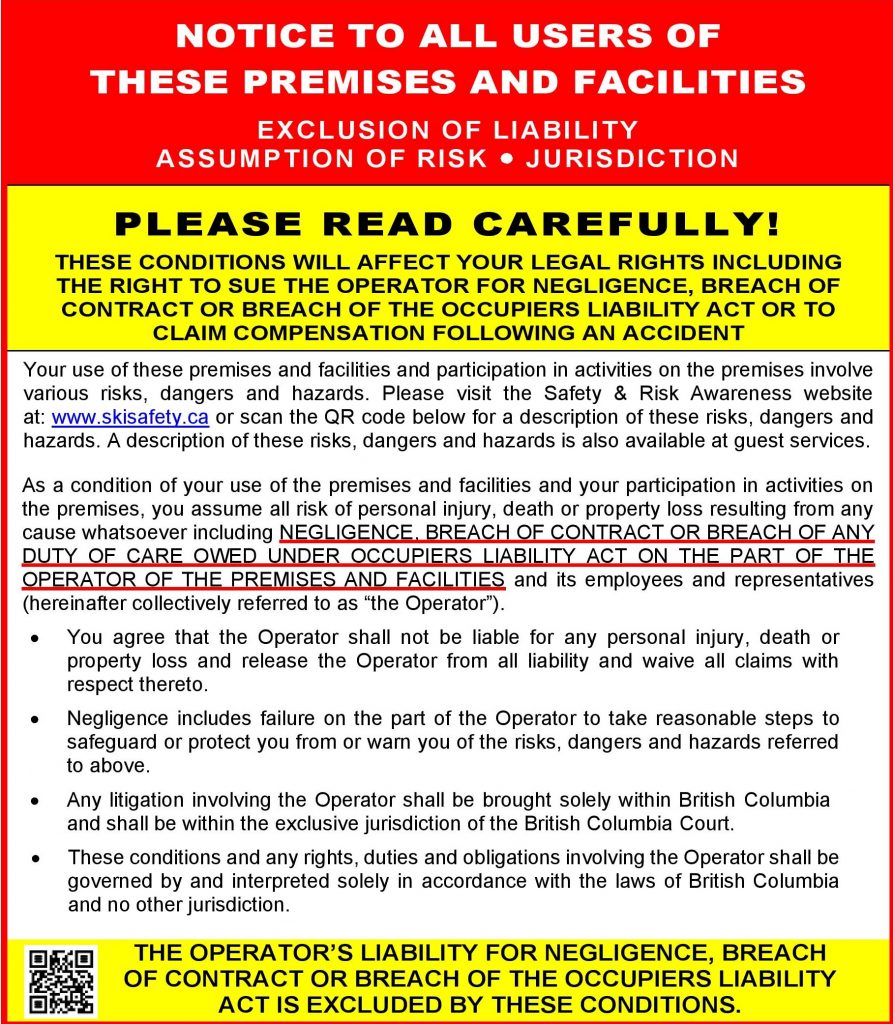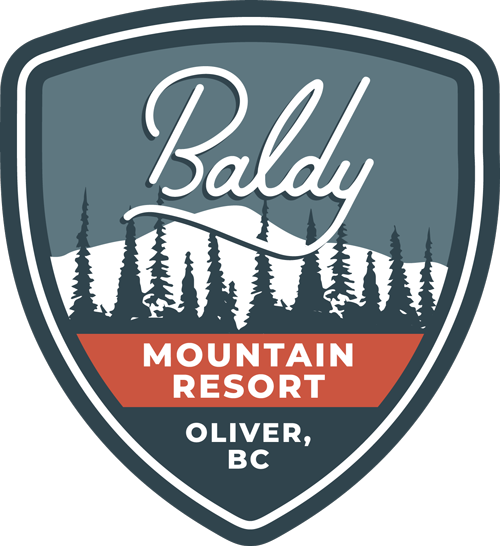Exclusion Of Liability
Assumption Of Risks
Assumption Of Risks
Skiing, snowboarding and other activities that take place at ski areas involve the risk of injury. The information contained in the Safety and Risk Awareness section of this website is intended to inform you of the risks, dangers and hazards that you may encounter at a ski area and help you to stay safe while enjoying these activities. Whether you are a participant in these activities or a parent or guardian of a minor participant, please take the time to familiarize yourself with the Safety and Risk Awareness information on this website.
The use of ski area premises and facilities and participation in activities at ski areas involves various risks, dangers and hazards. It is a condition of your use of the premises and facilities and your participation in these activities that you assume all risk of personal injury, death or property loss resulting from any cause whatsoever, including negligence, breach of contract, or breach of any duty of care on the part of the ski area operator. Your legal responsibility as a user of the ski area premises and facilities or participant in activities at the ski area is explained in the following notice, which you will see posted at the ski area.

Skiing and Snowboarding
Skiing, snowboarding, and cross country skiing (nordic) involves various risks, dangers and hazards including, but not limited to the following:
- boarding, riding and disembarking ski lifts;
- changing weather conditions;
- avalanches;
- exposed rock, earth, ice, and other natural objects;
- trees, tree wells, tree stumps and forest deadfall;
- the condition of snow or ice on or beneath the surface;
- variations in the terrain which may create blind spots or areas of reduced visibility
- variations in the surface or sub-surface, including changes due to man-made or artificial snow
- variable and difficult conditions
- streams, creeks, and exposed holes in the snow pack above streams or creeks
- cliffs; crevasses; snowcat roads, road-banks or cut-banks;
- collision with lift towers, fences, snow making equipment, snow grooming equipment, snowcats, snowmobiles or other vehicles, equipment or structures
- encounters with domestic and wild animals including dogs and bears
- collision with other persons
- loss of balance or control; slips, trips and falls;
- accidents during snow school lessons
- negligent first aid
- failure to act safely or within one’s own ability or to stay within designated areas
- negligence of other persons; and NEGLIGENCE ON THE PART OF THE OPERATOR.
Speed and Collision Safety
Ride Another Day
Complementing the Responsibility Code, #RideAnotherDay promotes three actions every skier and rider can take to help keep themselves and those around safer on the slopes. These three actions are:
Be Ready
Be ready to slow down or avoid objects or other people at any time. Ski and ride in such a way that you are always able to control yourself regardless of conditions and avoid others and objects you may encounter on the run, groomed or otherwise.
Stay Alert
Stay alert to what’s going on around you, especially other skiers and riders. Being aware of those around and changing conditions will help you have a fun and safe day on the hill.
Plan Ahead
Ease up at blind spots, check uphill when merging onto trails, and give other skiers plenty of room when passing. Look out for spots on the run where traffic merges or you can’t see what’s coming next. If you are unfamiliar with a run, take it easy the first time down it and make note of places where you’ll want to slow down, such as cat tracks and rollers. Also, give other skiers and riders lots or room, especially if you are passing them. There’s plenty of space out there, so there’s no need to crowd each other.
By doing these three things every run, you’ll be helping keep the slopes safe and enjoyable, for you and everyone else.
Slow Zone
Slow Zone banners and signs mark an area or areas of the ski hill where trails converge, base areas and where skiing fast poses a risk of injury or collision. Green runs are also generally considered to be slow zones. Please approach these areas slowly and with extreme caution. Not only is there higher traffic volumes in these areas, but they are often frequented by young children, beginners and seniors. Jumps and hits are not allowed in Slow Zones.
One of the biggest users of Green runs and Slow Zones are children. Children don’t have a high awareness of what other people are doing and are easily distracted. They might be on one side of the run and quickly without warning veer over and cross the run without checking to see if anyone is coming. Kids and adults that are learning to ski also tend to fall on terrain transitions (knolls) and can be trying to recover from a crash in an area that can’t be seen from above.
Failure to ski slowly and in control in the slow zones may result in lift privileges being revoked.
How fast is too fast?
Many people have a hard time remembering what it was like to be a beginner skier or snowboarder, and having to worry about whether there is enough space to attempt a turn. So first off, think about giving people some space. Next, remember that you must always be in control whether you are on an expert run or in a Slow Zone. This is the first point of the Alpine Responsibility Code. If you are in the air, you have no control over your speed or direction. The speed expected is relevant to how many people are on the run. When there are more people on the run the 10% Rule is in effect. You may pass people at a speed approximately 10% faster than the flow of other skier traffic on the run.
Ski Area Premises
When visiting a ski area, the premise is not limited to the ski runs – many ski areas will have day lodges, parking lots, restaurants, tube/tobogganing areas, terrain parks, walkways, access roads and other ski area facilities. You will come across signage throughout the ski area premise that are important to respect and understand. Please pay close attention to all signage. It is present for the safety of both guests and employees. Failing to follow the directions on these signs may result in the loss of your ticket or pass. It is your responsibility to be aware of mountain signage at all times.
Ski Area boundary

Most ski areas mark their operational boundaries with fencing or signage.
The terrain within the ski area boundary is patrolled by the ski patrol and some hazards are marked. The area beyond the ski area boundary is neither controlled nor patrolled by the ski patrol. Some ski areas permit skiers and snowboarders to travel beyond the ski area boundary into the backcountry. Backcountry travel can be very hazardous and requires specialized equipment, training and experience. Do not travel into the backcountry if you are not qualified to do so. Some ski areas may close their ski area boundaries or portions of the boundary. A closure sign must be respected and obeyed. Breach of a closure could result in the loss of ski area privileges and other sanctions.
Closed runs
Skiing and snowboarding in closed runs and areas is strictly prohibited. Runs are closed for several reasons: trees have fallen onto the run, ditches or holes have rendered the run unsafe, a race or other events are taking place, Terrain Parks are not yet ready to open, or perhaps machinery is operating. Observe and obey all posted signs and warnings. Ignoring these messages may put you at greater risk. Those who violate closures may lose lift privileges.
Marking, Flagging, Fencing
There are a number of different signs and markers to indicate conditions, boundaries and warnings on the Ski Area Premise.
All poles, flags, fencing, signage and padding on equipment or objects or other forms of marking devices are used by the ski area to inform you of the presence or location of a potential obstacle or hazard. These markers are no guarantee of your safety and will not protect you from injury. It is part of your responsibility under the Alpine Responsibility Code to avoid all obstacles or hazards, including those that are so marked. Inbound terrain includes natural hazards including cliffs and cornices. Ski with caution, unmarked objects and hazards may exist.
Relative trail difficulty
The designation of run difficulty is set by each ski area individually. Skiers and riders should be advised that a Green Circle, Blue Square or Black Diamond trails are not necessarily the same as a similarly rated trail at another area. Skiers and riders should work their way up, beginning with the easiest trails, no matter what their ability level may be, until they are familiar with the trails at each ski area.
Walking in ski areas
Walking in ski areas should not be overlooked as a risk, with potential for serious injuries. There are many wet, icy, slippery surfaces through the ski area premise. Slips, trips and falls are common and all users should take precautions at all times when travelling throughout a ski area. Ski boots and many types of other footwear do not provide good traction, and extra caution should be used when walking.
Explore
Baldy
Baldy


